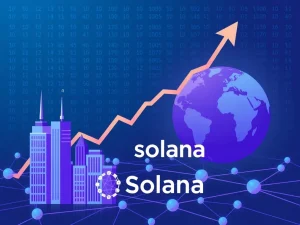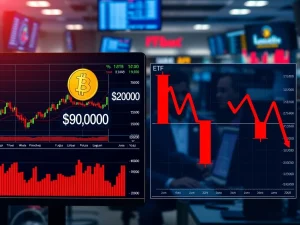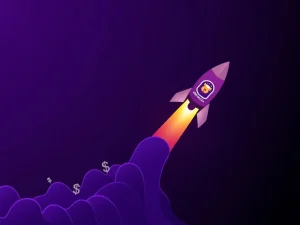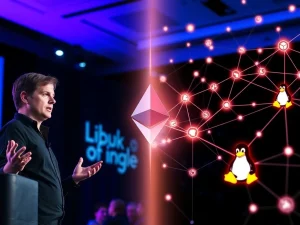RWA Tokenization: Revolutionary Trust Layer Unlocks Trillions in ESG Investment

The convergence of blockchain technology and real-world assets (RWAs) is creating an extraordinary opportunity. This shift is particularly impactful for institutions targeting sustainable market opportunities. It signals a potential influx of capital onto blockchain rails. Investors are now keenly observing how **RWA tokenization** is reshaping the investment landscape. It offers a new, robust framework for trust and transparency.
RWA Tokenization: Forging a New Blockchain Trust Layer
Real-world asset (RWA) tokenization involves minting financial and tangible assets onto a permanent blockchain ledger. This innovative process offers several compelling advantages. For instance, it enables fractional ownership, which broadens investor access. Furthermore, it provides 24/7 liquidity. These benefits are transformative for various asset classes. Crucially, RWA tokenization establishes a tamper-proof trust system. This system is often absent in traditional finance, especially within climate finance sectors.
Corey Billington, co-founder and CEO of tokenization infrastructure firm Blubird, emphasizes this point. Speaking during Crypto News Insights’s Chain Reaction daily live X spaces show, Billington noted, “The old system is very slow, very broken. Unfortunately, that’s where most of the market looks at the moment.” He explained how tokenized assets, such as non-fungible tokens (NFTs) representing a stake, act as an undeniable receipt. “A [tokenized NFT] is their receipt, and that cannot be doctored. It can’t be forged. Nothing can be done about that.” This mechanism fundamentally creates a new level of **blockchain trust**. It previously did not exist. Consequently, this may attract significant **institutional capital** onto the blockchain.
Driving Institutional Capital into ESG Investment
The global demand for Environmental, Social, and Governance (ESG) compliant investments is soaring. Investors seek opportunities that align with sustainability goals. However, traditional markets often struggle with transparency and efficiency in this area. Tokenized RWAs offer a powerful solution. They provide a verifiable and transparent means to invest in ESG initiatives. This includes projects focused on emission reduction and renewable energy. The inherent transparency of blockchain technology ensures that every transaction and asset detail is immutable. This builds unprecedented confidence for institutional investors.
This approach could bring billions, then trillions, in climate investments on-chain. Tokenization provides clear, auditable records of asset ownership and impact. It simplifies the due diligence process for large-scale investors. Furthermore, it opens new avenues for funding critical environmental projects. Institutions can now confidently allocate funds, knowing their investments are securely tracked and verified. This directly addresses the need for accountability in **ESG investment**. It thereby accelerates the flow of funds into impactful projects worldwide.
The $32 Billion Milestone: A Catalyst for Climate Finance
A significant development recently underscored the potential of RWA tokenization. Blubird, in collaboration with wealth tokenization platform Arx Veritas, tokenized an astounding $32 billion worth of Emission Reduction Assets (ERAs). This monumental effort prevented nearly 400 million tons of CO₂ emissions, as Crypto News Insights reported. This $32 billion achievement marks the largest tokenization event ever aligned with the ESG framework. It sets a new benchmark for what is possible in sustainable finance.
This milestone serves as a powerful proof of concept. It demonstrates the scalability and efficacy of tokenizing environmental assets. It also validates the concept of a new **blockchain trust** layer for large-scale **ESG investment**. The successful tokenization of such a substantial amount of ERAs highlights blockchain’s capacity. It can manage complex, high-value assets with integrity and efficiency. This event acts as a strong signal to other institutions. It shows them the tangible benefits and vast potential within **climate finance** through tokenization.
Streamlining Climate Finance: Overcoming Traditional Hurdles
Traditional systems for climate finance often face significant bottlenecks. These inefficiencies hinder the swift deployment of capital into crucial projects. For example, the verification process for carbon assets can be incredibly slow. Non-profit standard-setters, like Verra, developer of the widely used Verified Carbon Standard (VCS), may take up to 18 months for verification. This protracted timeline discourages investment and delays environmental impact. Corey Billington aptly described this as a “very slow, very broken” system. Such delays prevent urgent climate action.
RWA tokenization dramatically shortens these cycles. It provides immediate, verifiable proof of asset existence and ownership. This accelerates the entire investment process. For instance, once an asset is tokenized, its characteristics and impact are immutably recorded. This eliminates the need for lengthy, manual verification steps. Therefore, it creates a much more agile and responsive framework for **climate finance**. Billington noted that a tokenized NFT acts as an undeniable receipt. This removes any possibility of fraud or tampering. Consequently, it builds a superior level of **blockchain trust** for all participants.
The Future Landscape: Unlocking Trillions in Sustainable Institutional Capital
The issuance of tokenized ERAs is merely the beginning. It could bring trillions in **institutional capital** to the blockchain. Billington states that it “really creates a lot of new access points for climate finance.” These access points are currently limited by existing system inefficiencies. Blubird, for instance, already has more than $18 billion in tokenization deals lined up through 2026. This pipeline represents another 230 million tons of potential CO₂ emissions avoided. Such figures underscore the immense potential.
“We’re looking at roughly 230 million tons of CO₂ prevented emissions equivalent to that additional $18 billion pipeline,” Billington confirmed. If pipelines like Blubird’s continue to materialize, **RWA tokenization** could become the backbone of institutional **ESG investment** strategies by 2030. This transformative shift will not only unlock vast sums of capital but also ensure greater transparency and efficiency in sustainable development efforts. The integration of DeFi and CeFi, as suggested by Mantle 2.0, will further accelerate this convergence, solidifying tokenization’s role in global finance.
Enhancing Transparency and Accessibility with Blockchain Trust
The inherent transparency of blockchain technology is a cornerstone of this new trust layer. Every transaction, ownership record, and asset attribute is openly verifiable on the distributed ledger. This eliminates information asymmetry. It also significantly reduces the risk of fraud. For institutional investors, this level of transparency is invaluable. It provides an unprecedented degree of assurance and accountability. Consequently, this bolsters their confidence in tokenized assets.
Furthermore, **RWA tokenization** enhances accessibility for a broader range of investors. Fractional ownership allows smaller investors to participate in high-value assets. This democratizes investment opportunities. It also allows institutions to diversify their portfolios more effectively. The 24/7 liquidity offered by tokenized markets further improves investment flexibility. Ultimately, this combination of transparency, accessibility, and continuous liquidity builds robust **blockchain trust**. It drives forward the adoption of tokenized assets in **climate finance** and beyond.
In conclusion, RWA tokenization is rapidly establishing itself as a vital new ‘trust’ layer. It is poised to dramatically boost tokenized **ESG investment**. By addressing the inefficiencies and lack of transparency in traditional finance, blockchain technology is unlocking unprecedented amounts of **institutional capital**. This capital will flow into sustainable initiatives globally. The monumental $32 billion ERA tokenization event exemplifies this potential. It showcases a future where **climate finance** is more efficient, transparent, and accessible. This revolution promises to reshape the investment landscape for generations to come.









